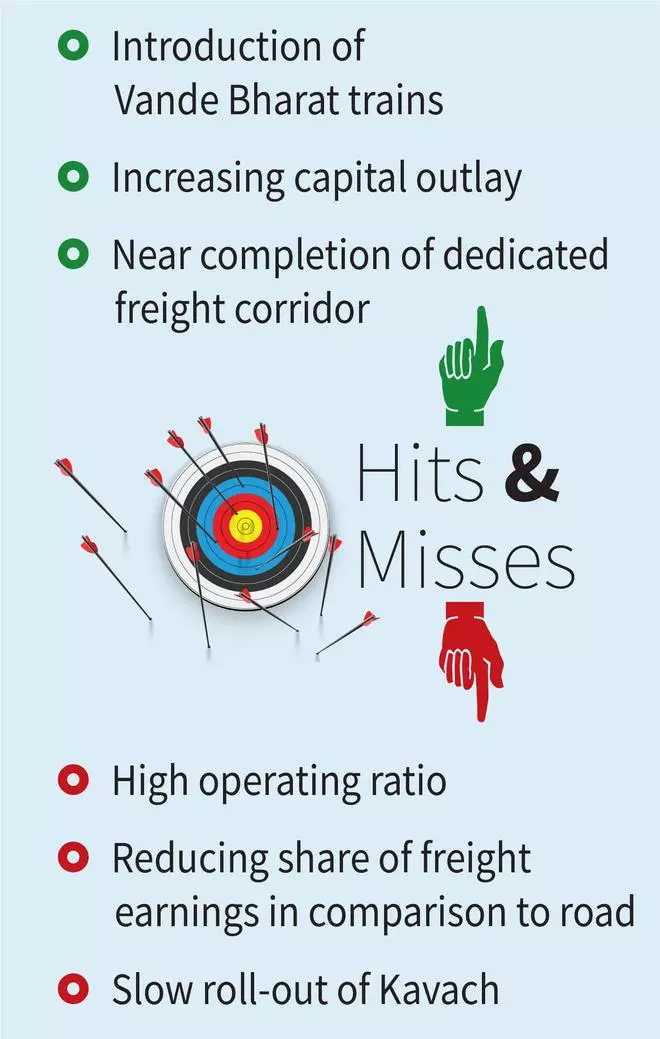A challenge before successive governments has been how to enhance efficiency of the country’s largest national transport network, the Indian Railways (IR). The two-terms of the NDA government has also had its share of challenges while dealing with the railways.

- Also read:Railway in better health today
Dealing with the Railways is not easy also because of its human resource as it is a big employer.
Fast track
In 1988, the late Madhavrao Scindia, then Railways Minister of the Rajiv Gandhi-led government, flagged-off the Shatabdi Express, between Delhi and Jhansi. Amongst the fastest trains in India, Shatabdi – travelling point-to-point – was inspired by the then Minster’s visits to Japan and France.
Cut to February 2019. Prime Minister Narendra Modi flagged off the first-ever Vande Bharat train — a super fast, indigenously-designed offering that marked not just a generational shift, but also a display of India’s manufacturing prowess.
Vande Bharat trains are now the fastest point-to-point services in India. The trains provide passenger amenities and services on par with airlines and are seen as an equivalent to Eurail.
Vande Bharat experiment
So far, there are 51 Vande Bharat trains operational – that include 34 with an eight-coach configuration, and 17 with 16-coach configurations.
Incidentally, export markets are also being tapped with Indian Railways now competing with the likes of Alstom.
Bullet trains are taking shape too. Construction work from the first ever bullet train service is currently underway between Mumbai and Ahmedabad. More high-speed train corridors are being considered now.
Safety Concerns
But, safety concerns cannot be ruled out. Installation of Kavach, the anti-collision system, is yet to pick up visible pace. And the Railways is yet again thinking of upgrading the same to LTE networks to improve services. Infrastructure complexities are seen as a hindrance. Driver fatigue has time and again cropped up during internal meetings of the Railways.
So far, Kavach has been deployed on 1,465 route km (Rkm) and 121 locomotives (including Electric Multiple Unit rakes) on South Central Railway in Telangana (684 Rkm), Andhra Pradesh (66 Rkm), Karnataka (117 Rkm) & Maharashtra (598 Rkm).
There are just two vendors of this technology at the moment and more are awaiting approval, according to Rail Ministry officials.
- Also read:Indian Railways set to modernize with ₹10-12 lakh crore investment over five years
The last 10 years have not been accident free for the Railways. There have been incidents, including the Balasore triple train accident in June 2023, that led to over 290 deaths, and is touted as one of the worst accidents in Indian Railways’ history.
Capital Outlay
While the Narendra Modi government will be remembered for merging the Rail Budget with the General Budget from 2017-18, it will also be seen for making the highest ever capital outlays for the Railways in two consecutive years – FY24 and FY25.
In FY24, the outlay was ₹240,000 crore and in this Interim Budget, it was ₹255,000 crore. Outlay went towards new track laying, electrification, ramp up in maintenance, among other categories. Border rail infra is also witnessing a boost, specially in the North East.
The Centre has also proposed three dedicated commodity corridors — energy, cement and minerals, port connectivity and high density traffic — while 95 per cent of the 2,843 km Dedicated Freight Corridor – proposed in 2006 and inherited (by the NDA) at zero construction in 2014 — has been commissioned. Near completion of the Dedicated Freight Corridor is seen as a major achievement.
Freight services continue to be the Railways’ cash-cow. While earnings from passenger services is around 30 per cent (and 70 per cent freight), line capacity utilisation (in passenger services) is close to 60 per cent.
The Railways is highly dependent on movement of coal (40 per cent), iron ore (10 per cent) and cement (10 per cent). The total freight being carried is less than 25 per cent of the total throughput. “Once you get the commodity routes and lay new high speed tracks, you free up the regular tracks for faster passenger train movement,” another official explained.
Electrification
Railway electrification projects have also been fast-tracked to attain the internal target of zero carbon emissions by 2030. Over ₹46,400 crore has been spent in electrification since 2014 and 40,000 route km have been electrified.

The average per day route electrification pace is now up to 19.6 km per day in FY24, as against 1.42 km per day in FY14.
- Also read:Railways doesn’t maintain separate profitability records of Vande Bharat, RTI response reveals
Around 5,300 km of new line laying (which also include doubling and gauge conversion) took place last fiscal, with the highest being around 14.5 km per day – a multi-year-high. “India is practically adding a Switzerland every year to its rail network,” Minister Ashwini Vaishnaw had said recently.
Under the Modi government, station modernisation assumed grandiose proportions. Some 1,321 stations are being re-developed under the Amrit Bharat station scheme. Foundation stone has been laid for over 500 stations and the ₹80,000-crore project is underway.
